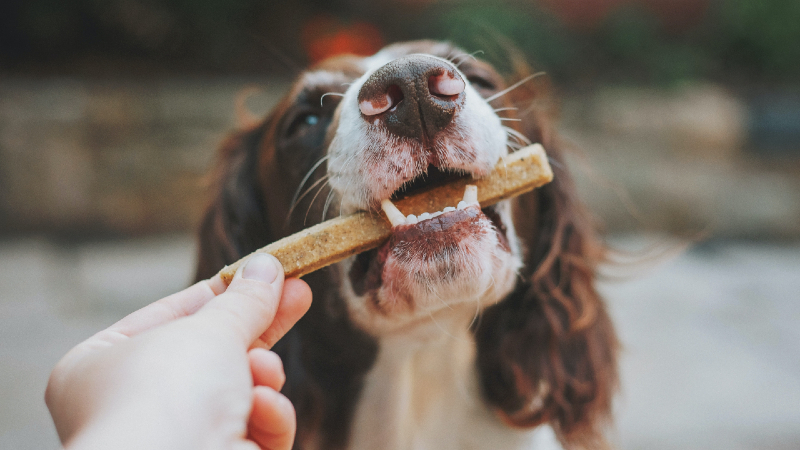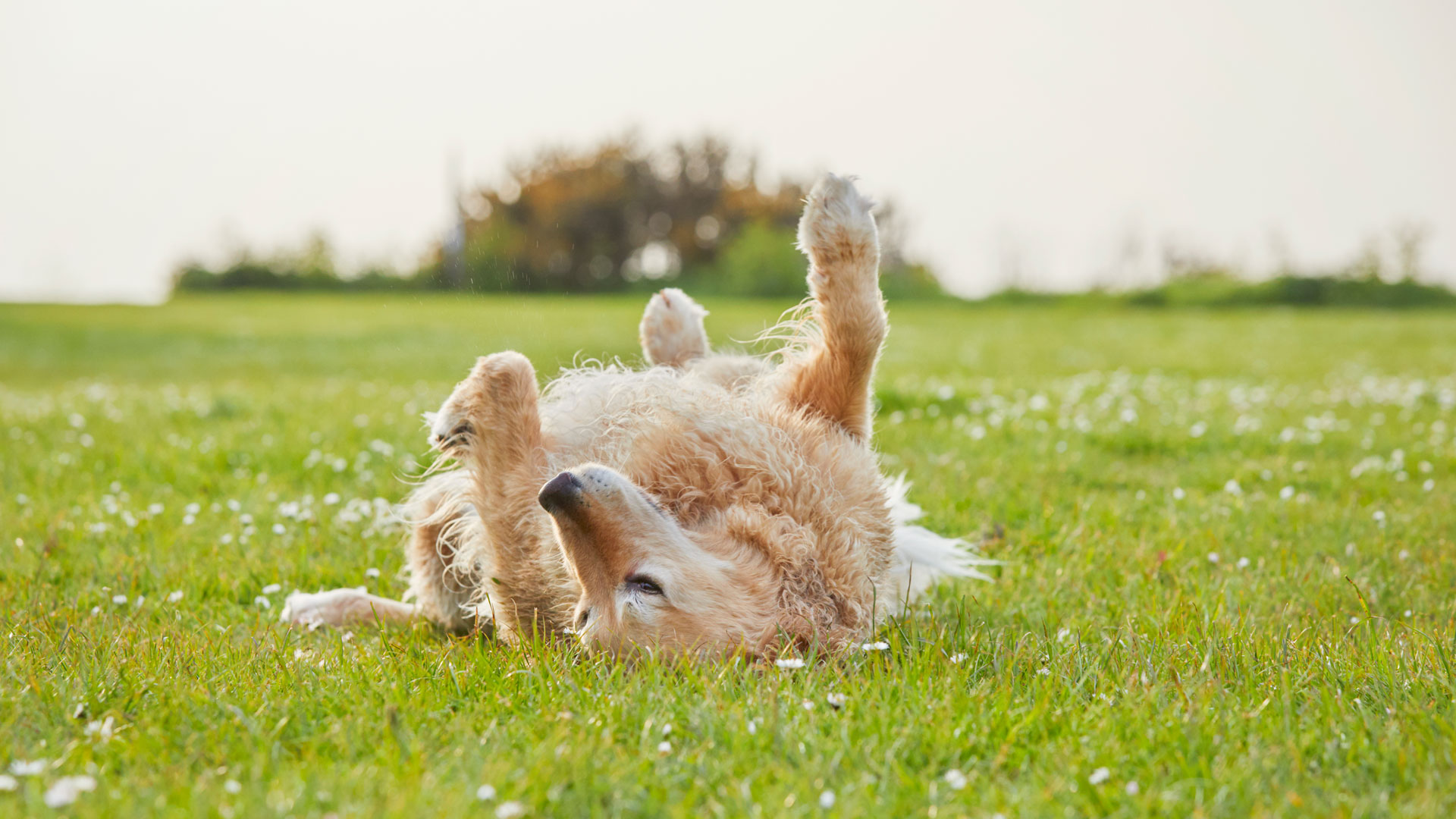How to calm a reactive dog
Experts share their top tips for how to calm a reactive dog

Learning how to calm a reactive dog is one of the most important skills you can master as a pet parent with a canine companion who tends to overreact to things in their environment.
Reactive dogs have certain triggers that cause them to have heightened reactions to certain stimuli. They may be happily playing with the best dog toys one minute and then start barking incessantly when the doorbell goes or a loud vehicle drives past.
While reactivity is often confused with dog aggression, it’s important to note that the two are different. Genetics, a frightening experience or a lack of training and socialization can cause a dog to overreact out of fear. Reactivity can escalate to aggression if not dealt with, but it is not aggressive in and of itself.
Having a reactive dog can be incredibly challenging and may leave you feeling like you can’t leave the house or invite people over. To help support you during this time we spoke to a variety of experts, including dog trainer and behaviorist Adam Daines and vet Dr. Joanna Woodnutt, to get their thoughts on how you can help your canine to feel calmer.
1. Have a strong daily routine
In a video shared to TikTok, expert dog trainer Miles Hamilton said that having a dog that’s calm, well behaved and obedient when you’re out and about together, starts with creating strong daily routines and structure within the home. "Everyone wants a trained dog who can go outside, listen around distractions, be super well-behaved, but many people inside the house have no structure whatsoever," Hamilton explains.
Having a strong and consistent daily routine, including set mealtimes, exercise times and rest times can help reactive dogs to feel safer and calmer because they know what to expect from one day to the next. Hamilton also advises using a crate and place board within the home. “These teach the dog to contain themselves mentally and help develop their impulse control.”
2. Create space when you’re out

“One of the best things to do with a reactive dog is to create space between them and the thing that scares them,” explains Woodnutt. “Every dog will have a distance that they’re comfortable with, you’ll need to experiment to find it for your dog. If they’re reacting to other dogs, moving off the path so they feel less threatened will make it a lot easier to get their attention. If your dog isn’t calming down, they probably need more space – you may need to cross the road, or even walk the other way until they’ve got enough space to calm down.”
Get the best advice, tips and top tech for your beloved Pets
3. Make some household changes
“Management is just as important as training!,” stresses Daines. “Think of behavior as a muscle, the more you use, the stronger it gets. That goes for both wanted and unwanted behaviors. If you're seeing unwanted behaviors that the dog is repeating and rehearsing, there's a good chance the dog feels there's a reward in it somewhere.
Simple solutions such as frosted vinyl can remove visual stimulation to avoid the dog barking at passers by, changing the doorbell to a new one is another easy way. For dogs who bark away the birds in the garden, put them on lead for a while when they go out to break the cycle. Stress that gets built up in the house doesn't just stay in the house, it affects your walks too. A dog full of adrenaline and cortisol leaving the house will be way more difficult to work with on a walk than if it left the house feeling calm.”
4. Reward calm behavior

Woodnutt says that when it comes to reactivity, rewarding your dog for being calm and relaxed is vital. “Once you’re further from the thing that’s worrying them, they should calm down a little, although you’ll notice they’re still on high alert. Try to keep their attention on you by giving them plenty of treats, perhaps in exchange for a small command like sitting. You’re trying to reward calm attention on you – you might need lots of treats! If your dog turns to look at the other dog again, call their name – once their attention is back on you, reward them.”
5. Use counter conditioning
“Counter conditioning, in short, aims to change how the dog feels about a certain trigger (dog, person, heavy traffic etc) from a negative association over to a positive association,” explains trainer and behaviorist Adam Daines. “Find something your dog loves, such as high value food, a toy, a game of chase etc. Find a spot where you can observe the trigger at a distance that your dog is comfortable with and immediately engage the dog in their favorite activity.
Through repetition, the dog will learn to associate the sight of the trigger with good things happening, and over time connect the dots that 'being in the presence of the trigger = fun stuff'. It's the same as if somebody kept handing me $20 notes for looking at someone I didn't like. Pretty soon they wouldn't seem so bad if they were the reason my fortune was increasing!”
6. Make sure you plan ahead
Prevention is always better than cure, so planning ahead and doing your best to avoid your dog’s known triggers is a great way to ensure they stay calm and comfortable. “Fireworks, other dogs on walks, trains going by – whatever it is, you’ll need to keep alert for and avoid where possible,” advises Woodnutt. “Trying to time your walks for quieter times or choosing routes with lots of paths so you can escape an oncoming dog can make the world of difference if your dog is reactive.”
7. Learn everything you can about canine body language

Learning how to speak ‘dog’ is one of the most important things you can do when it comes to helping your pup feel calm and relaxed. According to Julianna DeWillems, founder and head trainer at JW Dog Training & Behavior, dogs communicate with us all day long - they just obviously don’t use words.
"Learning to read your dog's body language completely opens up lines of communication between you two. Being able to notice more subtle body language, like the size and shape of your dog's eyes, if they've got tension around their mouth, where their ears are, to more obvious body language like if they're yawning, if they shake off, where they carry their tail can give you a ton of insight about how they're feeling and maybe even a guess about what they're thinking."
Happy dogs are loose and wiggly, whereas nervous or alert dogs tend to be tense. By paying attention to your dog’s body language, you’ll be able to tell when they’re feeling scared, uncomfortable or threatened.
8. Invest in the right equipment
"Safe, secure equipment is essential," explains Daines. "It not only allows the dog to feel comfortable in all situations, but can also relieve stress on the owner. If you worry about letting the dog off lead when out on walks, invest in a long line, a rubber woven line is my preference as it gives you the most grip of all the long lines on the market. If your dog settles better in a crate at home because it likes a den like atmosphere, make sure the area is big enough to meet the dogs needs."
We also highly recommend the best dog harness for pulling as this piece of kit, when paired with the appropriate training methods, can help reduce your dog's desire to pull or lunge.
9. Think about changing your routine
"In my reactivity programmes I always advise clients to start looking for routes where the dog hasn't had any negative experiences (which I know is very difficult), such as dogs barking at them through gates, as the dog is already anticipating the dog being there again, even if it's not, meaning your dog's adrenaline and cortisol levels are already increasing before you've actually seen a trigger!" Daines says.
"We also joke that there are magic portals on some walks. A cat might have ran out from under a car on a particular street, and for months afterwards the dog is expecting the magic portal to spit the cat out of the same place at any moment! If you have the option, try driving the dog to a secure field or quiet walk so they're in a better headspace generally for learning."
10. Seek professional help
“It’s important to seek professional help as soon as you see a problem, before you and your dog have had time to get into too many bad habits,” Woodnutt explains. “Your veterinarian can refer you to a clinical animal behaviorist. You might be asked to go in to visit the vet first, and it’s important that you do so – illnesses and pain can cause dogs to become reactive, so ruling these out is a good first step. Even if you don’t think this is likely, your vet might recommend a pain relief trial – a significant number of dogs improve, even if the cause of their pain isn’t obvious.”
Change is possible
Living with reactivity is hard, both for your dog and you. It’s important to have a plan in place that enables you to continuously work with your pup to make triggers less scary. Having a strong daily routine, making some household changes and rewarding your pup before they react to a trigger can all help to assist them in moving towards becoming less reactive.
If you find you have ongoing difficulties in this area, we recommend speaking with your vet and consulting a professional dog trainer who has experience in dealing with reactive dogs, both of whom will be able to customize strategies to suit the unique needs of your canine companion.
For more great training tips, check out our guide on common mistakes you should never make with a reactive dog and what this trainer has in her reactivity training kit

After graduating as a veterinarian from the University of Nottingham, Dr Joanna Woodnutt went on to practice companion animal medicine in the Midlands, UK. Dr Woodnutt is specifically interested in consulting and helping her clients understand their pets better, whether it’s around medical problems such as dermatology, behavior, and nutrition.

A UK member of the Association of Pet Dog Trainers, member of the UK Behaviour & Training Charter and a Victoria Stilwell Positively Dog Trainer Faculty Member and Faculty Advisor, Adam Daines strongly believes in positive reinforcement techniques and offers a range of dog training classes, behavior sessions, basic training and home visits.

Kathryn is a freelance writer who has been a member of the PetsRadar family since it launched in 2020. Highly experienced in her field, she's driven by a desire to provide pet parents with accurate, timely, and informative content that enables them to provide their fur friends with everything they need to thrive.
Kathryn works closely with vets and trainers to ensure all articles offer the most up-to-date information across a range of pet-related fields, from insights into health and behavior issues to tips on products and training.
When she’s not busy crafting the perfect sentence for her features, buying guides and news pieces, she can be found hanging out with her family (which includes one super sassy cat and a kitten), drinking copious amounts of Jasmine tea and reading all the books.
She has written for a range of publications, including Fit&Well, Top Ten Reviews, LiveScience, Goodto, and Product Hunt.
